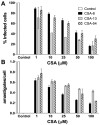Anti-trypanosomatid activity of ceragenins
- PMID: 19958044
- PMCID: PMC2891312
- DOI: 10.1645/GE-2329.1
Anti-trypanosomatid activity of ceragenins
Abstract
Cationic steroid antibiotics (CSAs), or ceragenins, are amphiphilic compounds consisting of a cholic acid backbone that is attached to several cationic amines. In this study, we tested the hypothesis that CSAs possess antiparasitic activities with minimal to no effects on mammalian cells, and thus could be used as potential therapeutic agents against pathogenic trypanosomatids. To investigate this notion, we synthesized CSAs and determined their trypanocidal and leishmanicidal activities in vitro. The 3 ceragenins assayed, i.e., CSA-8, CSA-13, and CSA-54, showed several degrees of parasiticidal activity. CSA-13 was the most effective compound against Leishmania major promastigotes and Trypanosoma cruzi trypomastigotes, at LD(50) 4.9 and 9 microM, respectively. The trypanocidal activities of these ceragenins were also assessed by infectivity experiments. We found CSA-8 was more effective on T. cruzi intracellular amastigotes when the infected host cells were treated for 24 hr (LD(50), 6.7 microM). Macrophages and LLC-MK(2) (treated for 72 hr) showed relative low susceptibility to these compounds. Our results suggest that ceragenins are indeed promising chemotherapeutic agents against trypanosomatids, but they require further investigation.
Figures




Similar articles
-
Identification of three classes of heteroaromatic compounds with activity against intracellular Trypanosoma cruzi by chemical library screening.PLoS Negl Trop Dis. 2009;3(2):e384. doi: 10.1371/journal.pntd.0000384. Epub 2009 Feb 24. PLoS Negl Trop Dis. 2009. PMID: 19238193 Free PMC article.
-
Assessment of leishmanicidal and trypanocidal activities of aliphatic diamine derivatives.Chem Biol Drug Des. 2013 Dec;82(6):697-704. doi: 10.1111/cbdd.12191. Epub 2013 Aug 10. Chem Biol Drug Des. 2013. PMID: 23865595
-
A Nature-Inspired Design Yields a New Class of Steroids Against Trypanosomatids.Molecules. 2019 Oct 22;24(20):3800. doi: 10.3390/molecules24203800. Molecules. 2019. PMID: 31652542 Free PMC article.
-
Metal-drug synergy: new ruthenium(II) complexes of ketoconazole are highly active against Leishmania major and Trypanosoma cruzi and nontoxic to human or murine normal cells.J Biol Inorg Chem. 2013 Oct;18(7):779-90. doi: 10.1007/s00775-013-1024-2. Epub 2013 Jul 24. J Biol Inorg Chem. 2013. PMID: 23881220 Free PMC article.
-
Antiprotozoal activity of quinonemethide triterpenes from Maytenus ilicifolia (Celastraceae).Molecules. 2013 Jan 15;18(1):1053-62. doi: 10.3390/molecules18011053. Molecules. 2013. PMID: 23322069 Free PMC article.
Cited by
-
Bactericidal Activity of Ceragenin CSA-13 in Cell Culture and in an Animal Model of Peritoneal Infection.Antimicrob Agents Chemother. 2015 Oct;59(10):6274-82. doi: 10.1128/AAC.00653-15. Epub 2015 Jul 27. Antimicrob Agents Chemother. 2015. PMID: 26248361 Free PMC article.
-
Development of Thiophene Compounds as Potent Chemotherapies for the Treatment of Cutaneous Leishmaniasis Caused by Leishmania major.Molecules. 2018 Jul 4;23(7):1626. doi: 10.3390/molecules23071626. Molecules. 2018. PMID: 29973498 Free PMC article.
-
Antibacterial and Antibiofilm Activities of Ceragenins against Pseudomonas aeruginosa Clinical Isolates.Turk J Pharm Sci. 2019 Dec;16(4):444-449. doi: 10.4274/tjps.galenos.2018.59023. Epub 2019 Nov 11. Turk J Pharm Sci. 2019. PMID: 32454748 Free PMC article.
-
Potential synergy activity of the novel ceragenin, CSA-13, against carbapenem-resistant Acinetobacter baumannii strains isolated from bacteremia patients.Biomed Res Int. 2014;2014:710273. doi: 10.1155/2014/710273. Epub 2014 Mar 24. Biomed Res Int. 2014. PMID: 24804236 Free PMC article.
-
Potential of ceragenin CSA-13 and its mixture with pluronic F-127 as treatment of topical bacterial infections.J Appl Microbiol. 2011 Jan;110(1):229-38. doi: 10.1111/j.1365-2672.2010.04874.x. Epub 2010 Oct 21. J Appl Microbiol. 2011. PMID: 20961363 Free PMC article.
References
-
- Acosta-Serrano A, Hutchinson C, Nakayasu ES, Almeida IC, Carrington M. Comparison and evolution of the surface architecture of trypanosomatid parasites. In: Barry JD, Mottram JC, McCulloch R, Acosta-Serrano A, editors. Trypanosomes: After the genome. Horizon Scientific Press; Norwich, U.K.: 2007. pp. 319–337.
-
- Andrews NW, Colli W. Adhesion and interiorization of Trypanosoma cruzi in mammalian cells. Journal of Protozoology. 1982;29:264–269. - PubMed
-
- Banuls AL, Hide M, Prugnolle F. Leishmania and the leishmaniases: A parasite genetic update and advances in taxonomy, epidemiology and pathogenicity in humans. Advances in Parasitology. 2007;64:1–109. - PubMed
-
- Bera A, Singh S, Nagaraj R, Vaidya T. Induction of autophagic cell death in Leishmania donovani by antimicrobial peptides. Molecular and Biochemical Parasitology. 2003;127:23–35. - PubMed
Publication types
MeSH terms
Substances
Grants and funding
LinkOut - more resources
Full Text Sources
Research Materials

